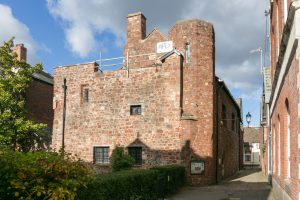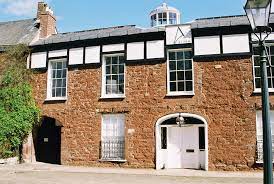On 17 November 2021 the Exeter University Club organised a visit to two of Exeter’s medieval buildings, rather an ambitious plan for a single day. A total of sixteen members attended but only a courageous few visited both the Devon and Exeter Institution in the morning and St Nicholas Priory in the afternoon, negotiating the winding stairways, low doors and passageways to discover a wealth of Exeter’s heritage. Peter Wingfield-Digby, a member and tour guide of the DEI, gave us a well-informed tour of the Institution, while Redcoat Guide Barry provided an entertaining and well-researched tour round St Nicholas Priory, enlivened with many anecdotes. Both sites have their own websites and excellent guidebooks or histories.
Both buildings have medieval origins, St Nicholas as a Benedictine priory in about 1087, a dependency of Battle Abbey, while No. 7 Cathedral Close was originally a canonical house owned by the Dean and Chapter of the Cathedral, its earliest recorded occupant being Canon William Browning in 1442. The priory preserves more of the medieval structure than no. 7, including the cellarium, the Norman undercroft dating from the 11th century, the oldest intact room in Exeter.
The cellarium contains a massive stone coffin, thought to be that of Sir Hugh Courtenay. If so, it must have been transferred at some date from Cowick Priory, where he was buried in 1292. The Courtenays of Powderham also have strong but less visible links with the DEI. In 1672 they leased no. 7 from the Dean and Chapter to use it as their town house. Since the early 17th century the Dean and Chapter had been leasing the property to non-clerical occupants: William Waller, later a general in Cromwell’s army, took over no. 7 from Sir Richard Reynell of Forde House in 1634. Sir William Courtenay had married William Waller’s daughter in 1643.


St Nicholas Priory lost its monastic status during the dissolution of the monasteries in 1536. The church and chapter house ranges were speedily demolished and the west and north ranges divided and sold off. Among the tenants in 1602 was Nicholas Hurst and the most striking room to be seen today is the parlour, reconstructed and repainted using contemporary panelling taken from 229 High Street, purchased at auction by RAMM in 2001 from the De Young Museum in San Francisco. Sadly the priory buildings were split into a rookery of tenements over the following three centuries until at the start of the twentieth century it was threatened with demolition.
The tale of no. 7 was more positive. The Courtenays maintained and redeveloped the building until 1813 when financial considerations forced the family to relinquish the lease, just at the time when the new DEI was looking for a place to rent. It is to the DEI that we are indebted for the present wonderful time capsule of a library, as they built the inner and outer library rooms with their galleries and cupolas. The inner room was originally intended as a lecture room but soon became filled with museum objects. Today it serves as a library for Westcountry studies while the outer room has always been a library room. The back of the building, including the Courtenay Room, resulting from reconstruction around 1600, is the only part of the early building to survive intact.


Only a few of the museum objects remain, notably the globes, frequent ornaments of a scholarly library. The remainder were passed to the Royal Albert Memorial Museum in 1869 to form part of their foundation collections. The Museum forms another link between the DEI and St Nicholas Priory as in 1913 the Exeter City Council purchased the decrepit buildings on behalf of the Museum. In 2018 the management of St Nicholas Priory was transferred to the Exeter Historic Buildings Trust, which had been established in 1996 to rescue the refectory range of the Priory, thus reuniting the two surviving wings of the priory.
So we were privileged to be shown the work of two charitable trusts which are flourishing to bring Exeter’s historical heritage before the wider community and visitors.
Ian Maxted
